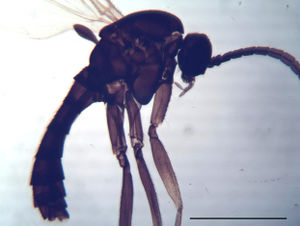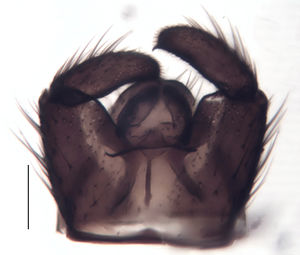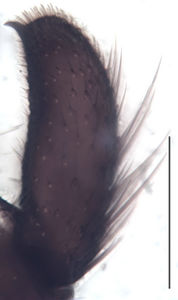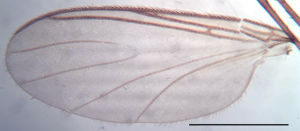Trichosiopsis coarctata
Ordo: Diptera
Familia: Sciaridae
Genus: Trichosiopsis
Name
Trichosiopsis coarctata Winnertz, 1867 – ZooBank link
- Sciara coarctata Winnertz, 1867[1]: 31–32
- Leptosciarella (Trichosiopsis) coarctata (Winnertz, 1867)[2]: 24–25
Type material
Lectotype ♀, no. 579, 3032 in ZFMK
Type locality
Germany, Frankfurt/Main
Description (male)
Head. Eye bridge 6–7 rows of facets. Antenna unicolour. LW-index of 4th flagellomere 1.85–2; neck 0.11–0.21 × segment width; transition of basal part to neck pronounced. Colour of neck unicolour. Antennal setae shorter than segment width; fine; dense; salient. Palpus darkened; of normal length, or long; palpomeres 3. First palpomere of normal shape, or elongate; with 7–10 setae; with only sparse sensilla. Second palpomere elongate. Third palpomere as long as first. Thorax. Colour dark brown. Notum unicolour. Thoracic setae long and strong, or normal; of different colours. Posterior pronotum setose. Postpronotal setae 3–7; fine. Mesothoracic sclerites setose. Mediotergite with 0 setae. Laterotergite with 3–4 setae. Legs. Colour yellow-brown, or patterned. Hind coxa of same colour as femora. Setae on front coxa pale. Front tibial organ as patch of setae; pale; front tibial organ not bordered. Tibial setae on hind legs very strong, as long or longer longer than tibial width. Tibial spurs of equal length. Claws untoothed. Wing. Wing slightly darkened; of normal shape. Wing membrane without macrotrichia. Wing venation weak, with faint stM. M-fork of normal shape. R1 ending at or slightly before base of m-fork; posterior veins with macrotrichia; stM mostly with macrotrichia; CuA1 and CuA2 mostly with macrotrichia; bM bare; r-m mostly setose; bM:r-M 0.45–0.65; st-Cu:bM 0.4–0.5; R1:R 1.4–1.7; c:w 0.56–0.66. Halter dark; of normal length. Abdomen. Abdominal setae dense; on tergites white; on sternites white. Hypopygium concolour with abdomen; LW-index 0.64–0.75. Base of gonocoxites with weak setae; gonocoxites broadly separated; inner margin of gonocoxites typically U-shaped; inner membrane of hypopygium scarcely setose; ventral margin of gonocoxite with short setae. Gonostylus elongate; LW-index 2.8–3.1; Inner margin straight; apex equally rounded. Apical tooth present; without internal structure; of medium strength; LW-Index 1.7–2.8. Awl-like setae normal; present beneath apical tooth. Megasetae absent. Whiplash-hair absent. Tegmen 0.4–0.6 × longer than broad; rectangular with rounded edges; without special features; central process absent. Length of ejaculatory apodeme/hypopygium 26–36 %; base of ejaculatory apodeme present. Field with aedeagal teeth inconspicuous. Measurements. Body size 2.8–3.5 mm. Hind tibia 1.4–1.65 mm. Wing length 2.6–3.4 mm.
Diagnosis
Tr. coarctata belongs to the Trichosiopsis trochanterata complex and here to the species with a setose laterotergite like Trichosiopsis hispida. It is characterized by a rounded and less tapered gonostylus than Tr. hispida, and patterned legs. The femora are brown and apically yellow.
DNA Barcoding
The COI sequences are assigned to five different BINs:
- BIN BOLD:ADA9417 (average distance 0.00%, max. 0.00%, n=4, K2P: 1.62%)
- BIN BOLD:ACS9404 (average distance 0.35%, max. 0.35%, n=2, K2P: 1.26%)
- BIN BOLD:ADA9418 (n=1, K2P: 1.26%)
- BIN BOLD:ACU4754 (n=1, K2P: 2.54%)
- BIN BOLD:ACR0682 (n=1, K2P: 5.46%)
Discussion
The female lectotype from Frankfurt/Main corresponds well with the barcoded female from Rhineland-Palatinate, which is not far away from the type locality. The wing is of typical shape and does not have a reduced anal lobe as the similar and closely related species Tr. hispida. Because of this, the females match better with the Tr. coarctata type specimen than with Tr. hispida. All studied specimens have contrasting two-coloured fore femora, the apical part being bright yellow and the basal part being brown. Unfortunately the fore legs are lacking in the lectotype of Tr. coarctata. Trichosiopsis coarctata is therefore morphologically easy to distinguish, but shows internally certain degree of cryptic diversity. Beside the “lowland” BIN BOLD:ADA9417, there are four further BINs, which are currently each represented by few individuals from Alpine regions and which are in part distinguished as distinct subspecies.
Distribution
Austria, Germany[1], Switzerland.
Subspecies list
Trichosiopsis coarctata coarctata - Trichosiopsis coarctata lapidaria - Trichosiopsis coarctata requaesta
Images
|





